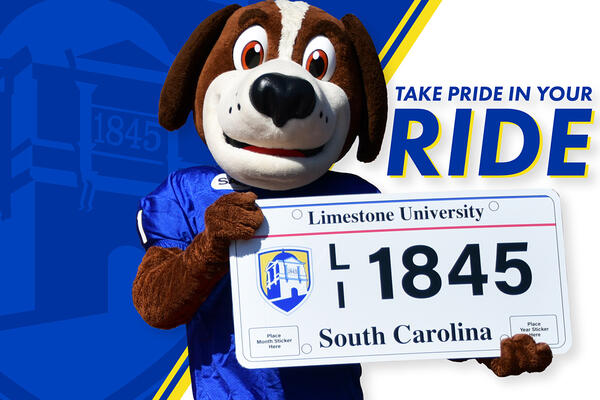January 21st, 2015
Limestone Students Bring Digital Smart Layer To Local Museum

Thanks to a special class project at Limestone College, portions of the Cherokee County History & Arts Museum have recently come alive with interactive displays that utilize modern technology.
Four students from the Digital Literacy II class of Communications Professor Dr. Randy Nichols have developed QR (Quick Response) Code labels at 15 different museum displays. Those matrix barcodes contain data that when scanned by a smart phone or tablet will provide visitors with video presentations about the respective museum displays.
“Our students did every bit of the work,” Dr. Nichols explained about what he calls the Digital Smart Layer added to the museum. “They made the QR Codes, came up with the questions, did the interviews, recorded the audio and video, mixed it, and developed the finished products. The hardest aspect of the entire project was deciding which portions of the interviews to use. We had some outstanding footage and we had to narrow each one down to about a minute or two, depending on the particular display.”
The Limestone students who developed Digital Smart Layer included Chaire Huminski, a senior from Roebuck; Zach Missel, a senior from Annapolis, MD; Nolan Wilson, a senior from Blacksburg; and Asaad Woods, a junior from Chandler, AZ.
“It was a really good learning experience for all of us,” said Huminski. “It’s cool seeing our work outside of the classroom environment. This project was placed in our hands to complete and we are very excited about the finished product. I am not originally from Cherokee County, but I enjoyed learning all about the history of this area. For example, I had no idea that this is the only county in the United States to have three national parks located within its boundaries. That is just so interesting and amazing.”
The QR Code system has become popular due to its fast readability and greater storage capacity compared to standard UPC barcodes. QR codes consist of black modules (square dots) arranged in a square grid on a white background, which can be read by an imaging device such as a smart phone or tablet. The Limestone students used an online website to create the actual codes.
Nichols pointed out that several museums also use smart phone and tablet technology, but many require visitors once they arrive to download proprietary applications to enjoy the interactive displays. That is not the case at the Cherokee County History Museum, where visitors simply use any QR reader application on their iOS, Android, or Windows devices.
For Director Billy Pennington, the Limestone project not only brought cutting edge technology to his museum, located at 301 College Drive in Gaffney, but it also preserved personal historical accounts that might have otherwise been lost.
“This provides us with another curation piece – a human element to go along with the displays,” said Pennington, who hand selected the subjects to be interviewed for Limestone’s project. “There are so many people who knew about so much of Cherokee County’s history and they are gone now. And their stories went with them. That’s history that’s lost forever.
“These interviews and these stories the Limestone students have recorded for us will also be here and be a part of our archives,” he continued. “I have imagined something like this for some time, but we just have not had the resources or the time to get it done. This adds a whole new layer to the museum. There is a story behind every single artifact, but we have not been able up until now to share all of that. This project will make the museum experience a lot more personable when people come in. This technology will let visitors see the reason why something is in here.”
The Digital Smart Layer includes interviews with Gaffney Mayor Henry Jolly, Vickie Roark, Lawrence Bright, Van “Turkey” Craig, Keefer Humphries, Nancy Westbrooks, Dr. Preston Edwards, and others. It also includes a piano performance of the “Battle of Cowpens” song by Dr. Gena Poovey, who is Professor of Choral/Vocal Music Education and Director of Choral Activities at Limestone College.
Both Nichols and Pennington hope that the project can be expanded well into the future. Nichols said that future Limestone History and Communications interns at the museum will be able to add more interactive displays in the future using the QR codes method.
As for Pennington, he said that the museum benefits from the assistance it gets from Limestone, and that the facility also enhances those students’ experiences while they are in Cherokee County.
“Being a part of the museum has helped the students on this project better appreciate the community that they are a part of,” he noted. “They didn’t necessarily come in here seeking to know more about Cherokee County’s history, but once they got into it, they found it very interesting. It would be nice for many more students at Limestone to learn more about our local history because it’s really fascinating. This QR Code project will go a long way in doing that for the College students, for our local students, and for our community.”
On Tuesday, Jan. 27, from 5 p.m. until 7 p.m. the Cherokee County History & Arts Museum will hold a reception to debut the new Digital Smart Layer. The event, offering free admission into the facility, is being co-sponsored by the museum and the Communications Department at Limestone.



